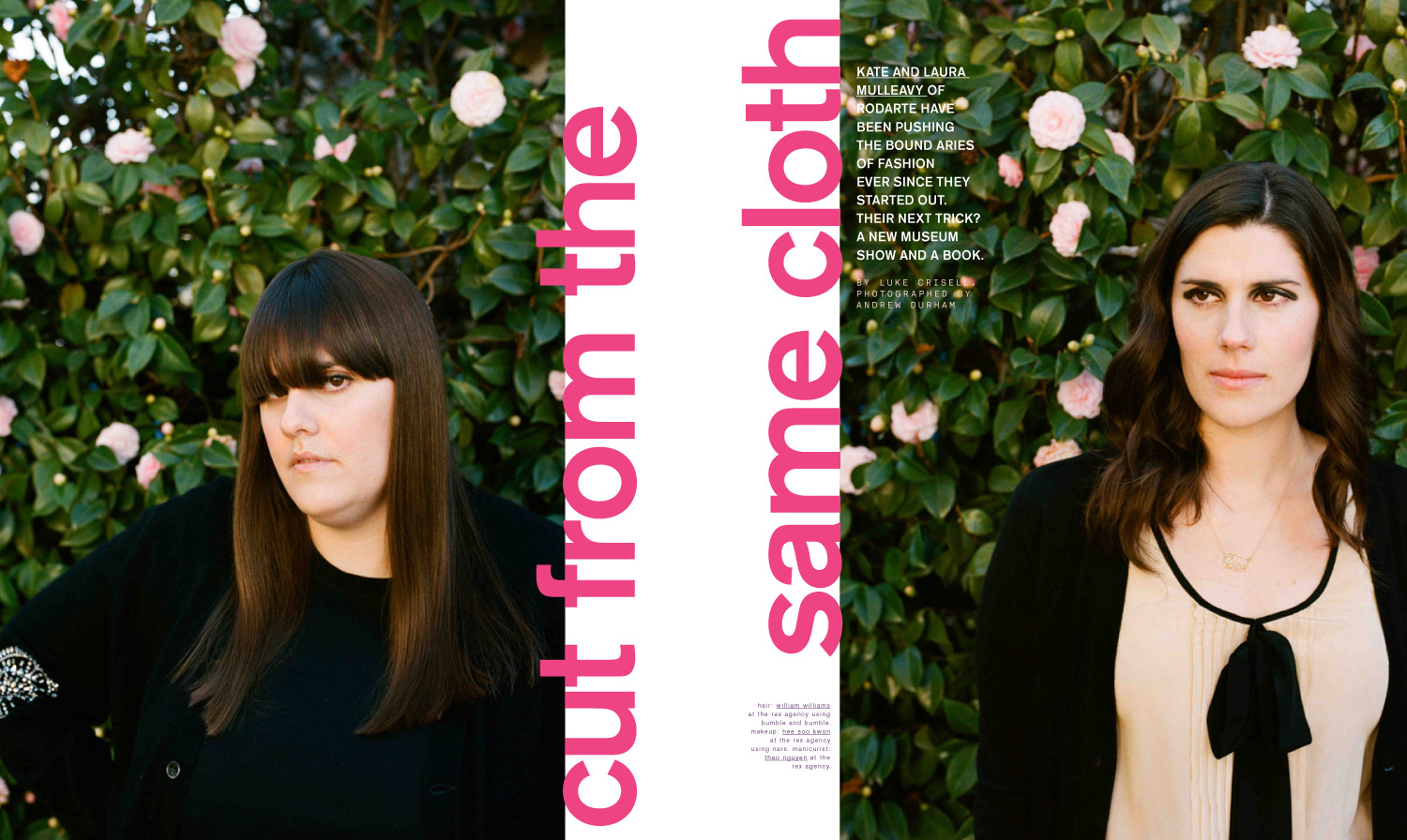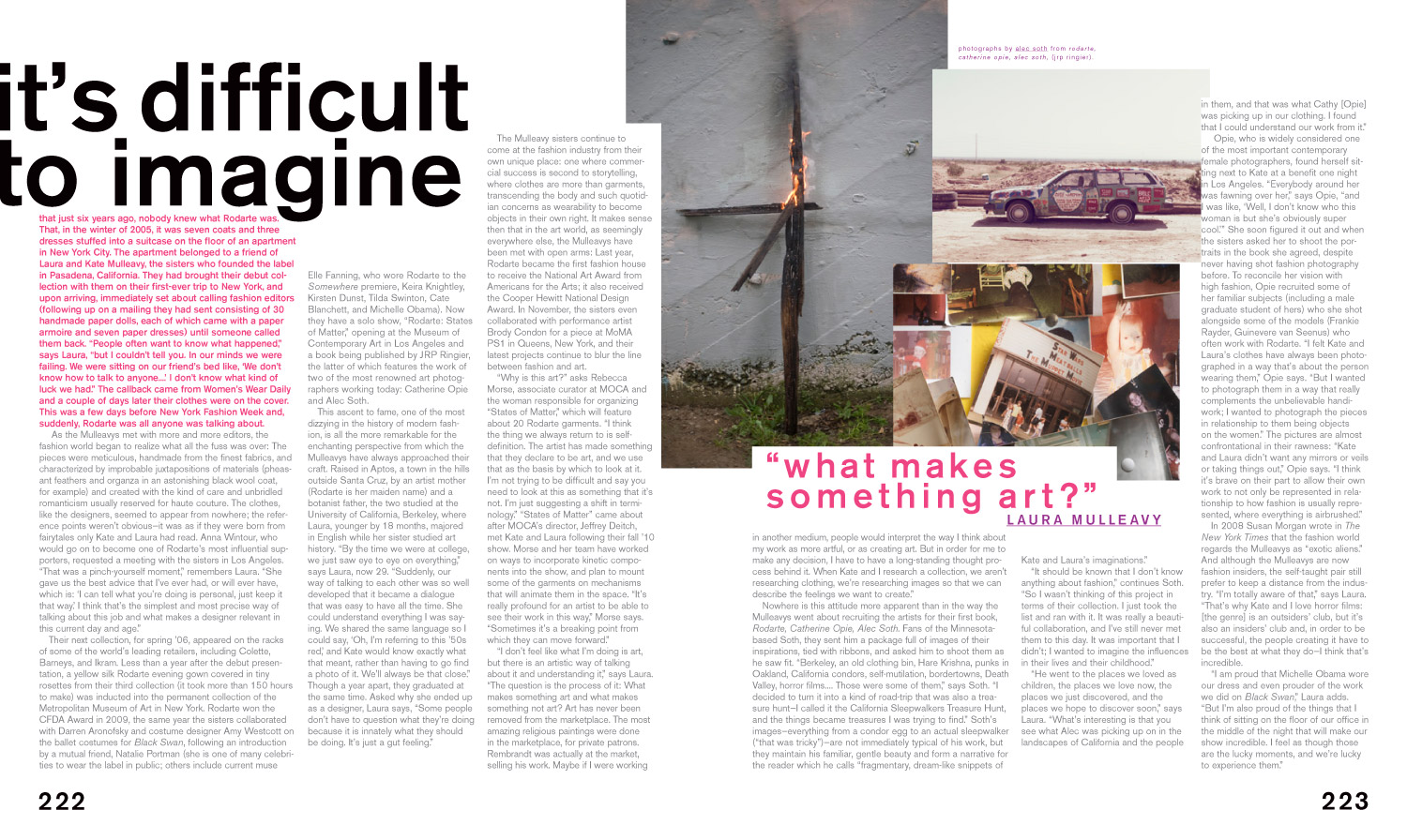CUT FROM THE SAME CLOTH
IT’S DIFFICULT TO IMAGINE that just six years ago, nobody knew what Rodarte was. That, in the winter of 2005, it was seven coats and three dresses stuffed into a suitcase on the floor of an apartment in New York City. The apartment belonged to a friend of Laura and Kate Mulleavy, the sisters who founded the label in Pasadena, California. They had brought their debut collection with them on their first-ever trip to New York, and upon arriving, immediately set about calling fashion editors (following up on a mailing they had sent consisting of 30 handmade paper dolls, each of which came with a paper armoire and seven paper dresses) until someone called them back. “People often want to know what happened,” says Laura, “but I couldn’t tell you. In our minds we were failing. We were sitting on our friend’s bed like, ‘We don’t know how to talk to anyone....’ I don’t know what kind of luck we had.” The callback came from Women’s Wear Daily and a couple of days later their clothes were on the cover. This was a few days before New York Fashion Week and, suddenly, Rodarte was all anyone was talking about.
As the Mulleavys met with more and more editors, the fashion world began to realize what all the fuss was over: The pieces were meticulous, handmade from the finest fabrics, and characterized by improbable juxtapositions of materials (pheasant feathers and organza in an astonishing black wool coat, for example) and created with the kind of care and unbridled romanticism usually reserved for haute couture. The clothes, like the designers, seemed to appear from nowhere; the reference points weren’t obvious—it was as if they were born from fairytales only Kate and Laura had read. Anna Wintour, who would go on to become one of Rodarte’s most influential supporters, requested a meeting with the sisters in Los Angeles. “That was a pinch-yourself moment,” remembers Laura. “She gave us the best advice that I’ve ever had, or will ever have, which is: ‘I can tell what you’re doing is personal, just keep it that way.’ I think that’s the simplest and most precise way of talking about this job and what makes a designer relevant in this current day and age.”
Their next collection, for spring ’06, appeared on the racks of some of the world’s leading retailers, including Colette, Barneys, and Ikram. Less than a year after the debut presentation, a yellow silk Rodarte evening gown covered in tiny rosettes from their third collection (it took more than 150 hours to make) was inducted into the permanent collection of the Metropolitan Museum of Art in New York. Rodarte won the CFDA Award in 2009, the same year the sisters collaborated with Darren Aronofsky and costume designer Amy Westcott on the ballet costumes for Black Swan, following an introduction by a mutual friend, Natalie Portman (she is one of many celebrities to wear the label in public; others include current muse Elle Fanning, who wore Rodarte to the Somewhere premiere, Keira Knightley, Kirsten Dunst, Tilda Swinton, Cate Blanchett, and Michelle Obama). Now they have a solo show, “Rodarte: States of Matter,” opening at the Museum of Contemporary Art in Los Angeles and a book being published by JRP Ringier, the latter of which features the work of two of the most renowned art photographers working today: Catherine Opie and Alec Soth.
This ascent to fame, one of the most dizzying in the history of modern fashion, is all the more remarkable for the enchanting perspective from which the Mulleavys have always approached their craft. Raised in Aptos, a town in the hills outside Santa Cruz, by an artist mother (Rodarte is her maiden name) and a botanist father, the two studied at the University of California, Berkeley, where Laura, younger by 18 months, majored in English while her sister studied art history. “By the time we were at college, we just saw eye to eye on everything,” says Laura, now 29. “Suddenly, our way of talking to each other was so well developed that it became a dialogue that was easy to have all the time. She could understand everything I was saying. We shared the same language so I could say, ‘Oh, I’m referring to this ’50s red,’ and Kate would know exactly what that meant, rather than having to go find a photo of it. We’ll always be that close.” Though a year apart, they graduated at the same time. Asked why she ended up as a designer, Laura says, “Some people don’t have to question what they’re doing because it is innately what they should be doing. It’s just a gut feeling.”
The Mulleavy sisters continue to come at the fashion industry from their own unique place: one where commercial success is second to storytelling, where clothes are more than garments, transcending the body and such quotidian concerns as wearability to become objects in their own right. It makes sense then that in the art world, as seemingly everywhere else, the Mulleavys have been met with open arms: Last year, Rodarte became the first fashion house to receive the National Art Award from Americans for the Arts; it also received the Cooper Hewitt National Design Award. In November, the sisters even collaborated with performance artist Brody Condon for a piece at MoMA PS1 in Queens, New York, and their latest projects continue to blur the line between fashion and art.
“Why is this art?” asks Rebecca Morse, associate curator at MOCA and the woman responsible for organizing “States of Matter,” which will feature about 20 Rodarte garments. “I think the thing we always return to is self- definition. The artist has made something that they declare to be art, and we use that as the basis by which to look at it. I’m not trying to be difficult and say you need to look at this as something that it’s not. I’m just suggesting a shift in terminology.” “States of Matter” came about after MOCA’s director, Jeffrey Deitch, met Kate and Laura following their fall ’10 show. Morse and her team have worked on ways to incorporate kinetic components into the show, and plan to mount some of the garments on mechanisms that will animate them in the space. “It’s really profound for an artist to be able to see their work in this way,” Morse says. “Sometimes it’s a breaking point from which they can move forward.”
“I don’t feel like what I’m doing is art, but there is an artistic way of talking about it and understanding it,” says Laura. “The question is the process of it: What makes something art and what makes something not art? Art has never been removed from the marketplace. The most amazing religious paintings were done in the market place, for private patrons. Rembrandt was actually at the market, selling his work. Maybe if I were working in another medium, people would interpret the way I think about my work as more artful, or as creating art. But in order for me to make any decision, I have to have a long-standing thought process behind it. When Kate and I research a collection, we aren’t researching clothing, we’re researching images so that we can describe the feelings we want to create.”
Nowhere is this attitude more apparent than in the way the Mulleavys went about recruiting the artists for their first book, Rodarte, Catherine Opie, Alec Soth. Fans of the Minnesota-based Soth, they sent him a package full of images of their inspirations, tied with ribbons, and asked him to shoot them as he saw fit. “Berkeley, an old clothing bin, Hare Krishna, punks in Oakland, California condors, self-mutilation, bordertowns, Death Valley, horror films.... Those were some of them,” says Soth. “I decided to turn it into a kind of road-trip that was also a treasure hunt—I called it the California Sleepwalkers Treasure Hunt, and the things became treasures I was trying to find.” Soth’s images—everything from a condor egg to an actual sleepwalker (“that was tricky”)—are not immediately typical of his work, but they maintain his familiar, gentle beauty and form a narrative for the reader which he calls “fragmentary, dream-like snippets of Kate and Laura’s imaginations.” It should be known that I don’t know anything about fashion,” continues Soth. “So I wasn’t thinking of this project in terms of their collection. I just took the list and ran with it. It was really a beautiful collaboration, and I’ve still never met them to this day. It was important that I didn’t; I wanted to imagine the influences in their lives and their childhood.”
“He went to the places we loved as children, the places we love now, the places we just discovered, and the places we hope to discover soon,” says Laura. “What’s interesting is that you see what Alec was picking up on in the landscapes of California and the people in them, and that was what Cathy [Opie] was picking up in our clothing. I found that I could understand our work from it.”
Opie, who is widely considered one of the most important contemporary female photographers, found herself sitting next to Kate at a benefit one night in Los Angeles. “Everybody around her was fawning over her,” says Opie, “and I was like, ‘Well, I don’t know who this woman is but she’s obviously super cool.’” She soon figured it out and when the sisters asked her to shoot the portraits in the book she agreed, despite never having shot fashion photography before. To reconcile her vision with high fashion, Opie recruited some of her familiar subjects (including a male graduate student of hers) who she shot alongside some of the models (Frankie Rayder, Guinevere van Seenus) who often work with Rodarte. “I felt Kate and Laura’s clothes have always been photo- graphed in a way that’s about the person wearing them,” Opie says. “But I wanted to photograph them in a way that really complements the unbelievable handiwork; I wanted to photograph the pieces in relationship to them being objects on the women.” The pictures are almost confrontational in their rawness: “Kate and Laura didn’t want any mirrors or veils or taking things out,” Opie says. “I think it’s brave on their part to allow their own work to not only be represented in relationship to how fashion is usually represented, where everything is airbrushed.”
In 2008 Susan Morgan wrote in The New York Times that the fashion world regards the Mulleavys as “exotic aliens.” And although the Mulleavys are now fashion insiders, the self-taught pair still prefer to keep a distance from the industry. “I’m totally aware of that,” says Laura. “That’s why Kate and I love horror films: [the genre] is an outsiders’ club, but it’s also an insiders’ club and, in order to be successful, the people creating it have to be the best at what they do—I think that’s incredible.
“I am proud that Michelle Obama wore our dress and even prouder of the work we did on Black Swan,” Laura adds. “But I’m also proud of the things that I think of sitting on the floor of our office in the middle of the night that will make our show incredible. I feel as though those are the lucky moments, and we’re lucky to experience them.”

